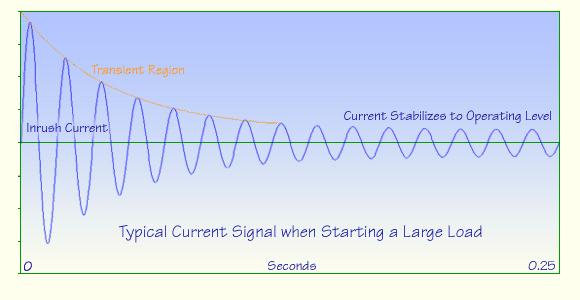 |
 |
 |
 |
 |
Transients |
|
Transients are the transitory characteristics of current or voltage whenever there is a
short-duration change of current (load), i.e., whenever an appliance is turned on or off.
All physical systems have inertia, and transients are the changes that physical systems
must go through in order to adjust to a new state.
Depending on the size of the load, different amounts of inertia
may be involved; very small loads have extremely short transients in the range
of millionths of a second, while large loads typically have transients in the tenths of a second.
|
|
The acceleration of a car from zero
to a cruising speed is a form of transient. During this transition period, accelerating forces
are experienced by passengers, pinning them against their seats.
Once the car reaches its cruising speed, the acceleration force ceases and people,
moving at the speed of the car, feel free to move about; the transitory event is over. |
|
|
 
|
|
Motor-starting transients are examples of time variability that results
from the abrupt starting or stopping of appliances drawing large currents, such as
pumps. The figure below shows
a current transient associated with a large motor load when the motor is started.
|
|
During the start-up of an electric motor, there is an inrush of
current much larger than the operating current,
as the motor must transition from standing still to slow rotation,
and then to full rotation at its design speed.
This inrush current, which may manifest in stray voltage
as well, is very brief, often lasting only a fraction of a second.
After the motor has reached operating speed, the amount of energy required
to keep it spinning—and therefore the amount of current it draws—is
significantly reduced. The transient dwindles to a steady state level.
|
 
|

|
 
|
|
While the figure depicts a current transient, the same is true for voltage
or stray voltage transients.
|
|
Motor-starting stray voltage transients are usually not
a concern because exposure is very brief, and motor start-ups are
isolated events of a limited number. On a typical farm, significant motor-start
transients (those that appear at animal contact locations above a
level of perception) may last only a few seconds each day. In order
to be exposed to the voltage gradients created, cows would have to be
in the right place at the right time, the odds of which are low.
Stray voltage motor-starting transients present between a waterer
and the earth for few seconds per day would not be likely to cause a cow
to stop drinking water. In fact, the majority of cows in the herd
would not be aware that transient voltages were present. |





|
|
 |
|
 |
 |
|
